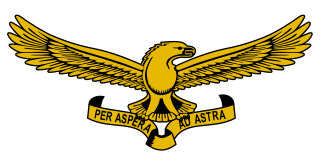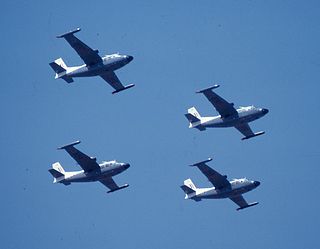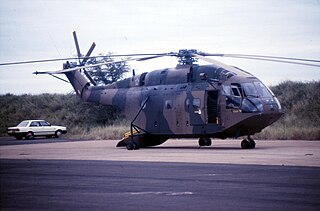
No. 206 Squadron is a Test and Evaluation Squadron of the Royal Air Force. Until 2005 it was employed in the maritime patrol role with the Nimrod MR.2 at RAF Kinloss, Moray. It was announced in December 2004 that 206 Squadron would disband on 1 April 2005, with half of its crews being redistributed to Nos. 120 and 201 Squadrons, also stationed at Kinloss. This was a part of the UK Defence Review called Delivering Security in a Changing World; the Nimrod MR.2 fleet was reduced in number from 21 to 16 as a consequence.

The South African Air Force (SAAF) is the air warfare branch of South African National Defence Force, with its headquarters in Pretoria. The South African Air Force was established on 1 February 1920. The Air Force saw service in World War II and the Korean War. From 1966, the SAAF was involved in providing infantry support in the low-intensity Border War in Angola, South-West Africa and Rhodesia. As the war progressed, the intensity of air operations increased, until in the late 1980s when the SAAF were compelled to fly fighter missions against Angolan aircraft in order to maintain tactical air superiority. On conclusion of the Border War in 1990, aircraft numbers were severely reduced due to economic pressures as well as the cessation of hostilities with neighbouring states.

The Lockheed Ventura is a twin-engine medium bomber and patrol bomber of World War II.

22 Squadron is a squadron of the South African Air Force. It is currently a maritime helicopter squadron operating Lynx and Oryx helicopters for the South African Navy. Originally formed in 1942, the squadron is the only current maritime helicopter squadron of the SAAF. It has been involved with many rescues, some gaining international attention as well as arctic base support.

24 Squadron SAAF is a disbanded squadron of the South African Air Force. Its last role was as an attack aircraft squadron. The squadron was first formed during World War II on 5 March 1941 by renumbering 14 Squadron SAAF in Egypt. It later carried out bombing operations in Kenya and North Africa, before taking part in the Italian campaign before disbanding in late 1945 at the conclusion of hostilities. The squadron was later re-raised and operated jet aircraft in an attack role during the Border War. It was finally disbanded in early 1991.

No. 500 Squadron AAF was a Royal Air Force flying squadron. It was initially formed in 1931 as a Special Reserve squadron and in 1936 became part of the Auxiliary Air Force, at this time based at Manston and Detling.

Royal Air Force Talbenny, or more simply RAF Talbenny, is a former Royal Air Force station located 5.6 miles (9.0 km) north west of Milford Haven, Pembrokeshire and 7.9 miles (12.7 km) south west of Haverfordwest, Pembrokeshire, Wales.

3 Squadron SAAF was a squadron of the South African Air Force. It was formed in January 1939 at Air Force Base Waterkloof and was equipped with Hawker Hartbees I and Hurricane Mk II aircraft. The squadron was moved to Port Elizabeth in September 1939 after which it was disbanded. It was again reformed at Waterkloof on 9 September 1940 equipped with Hurricane Mk 1s.

5 Squadron SAAF was a South African Air Force Fighter / Fighter-Bomber squadron during World War II. It was disbanded at the end of the war and was re-commissioned in 1950. It remained active until 2 October 1992, when it was disbanded; its Atlas Cheetah E aircraft were also decommissioned.

6 Squadron was a South African Air Force unit first formed just before World War II. It was disbanded and re-created a number of times, until finally disbanded in October 1990.

12 Squadron was a South African Air Force squadron that served in the Second World War in East Africa and the Western Desert as a medium bomber squadron. After the war, the squadron was used in various roles, including that of a helicopter squadron until 1963, when it was equipped with English Electric Canberra light bombers, remaining a light bomber and reconnaissance squadron until disbanded in 1990.

10 Squadron was a squadron of the South African Air Force. It was formed as a fighter bomber unit on 1 April 1939 and was deployed in a coastal defence role as part of Coastal Command SAAF until 1943. It was disbanded after the threat of Japanese naval actions off the South African coast had waned. It was re-activated as a fighter squadron on 25 May 1944 and deployed to the Middle East where the squadron saw service in Syria, Libya and the Aegean and was disbanded at the end of the war in Italy.

32 Squadron was a short lived coastal patrol squadron of the South African Air Force during the Second World War. It was founded in December 1939 and assumed the responsibility for coastal patrols and anti-submarine escorts for shipping. The squadron never had many aircraft and remained a small unit for the full duration of its short existence. It was disbanded in August 1940 when its Ju-86 aircraft were sent to Johannesburg to augment 12 Squadron who were deployed in East Africa.

29 Squadron was one of the Coastal Command SAAF of the South African Air Force during the Second World War. It was assigned the role of maritime patrol and shipping escort and operated Venturas from Lombazi on the Pondoland coast. With the decline in activities in the war at sea, the squadron was disbanded on 15 November 1943 and absorbed into 29 Operational Training Unit based at Darling in the Cape. The squadron was re-activated in August 1944 and deployed to Matubatuba in Zululand from where it once again operated with Venturas. At this time, the squadron did very little flying and was disbanded at the end of the war.

27 Squadron was established as a World War II maritime patrol squadron of the South African Air Force. It was disbanded after the war and resurrected in the same role from 1951 to 1958. Its final period of service was from 1962 to 1990 when it was finally disbanded when its Piaggio Albatross aircraft were de-commissioned.

31 Squadron was initially a World War II Coastal bomber/reconnaissance squadron South African Air Force. It was later converted to a heavy bomber squadron that operated from bases in the Mediterranean from January 1944 until the end of the war. On conclusion of hostilities, the squadron was used to ferry liberated POW's from Italy back to Britain and disbanded South African troops from Italy to Egypt. It was disbanded on 15 December 1945. It was resurrected as a medium and light helicopter squadron in 1982 and operated from AFB Hoedspruit until its final disbandment on 4 December 1992.

30 Squadron SAAF was a squadron of the South African Air Force. It was established in 1944 and saw service as a medium bomber squadron in Italy during the Second World War. After the war, the squadron was disbanded and was resurrected in 1980 as a medium transport helicopter squadron – a role it retained until it was finally disbanded in 1991.
The History of the South African Air Force spans the First World War, Rand Rebellion of 1922, the Second World War, the Korean War, the South African Border War, and varied peacekeeping operations since 1994. Its battle honours include German South West Africa 1914–15, German East Africa 1915–1918, East Africa: 1939–1941, Middle East: 1941–43, Madagascar 1942, Italy 1943–1945, the Balkans 1943–1945, and Korea 1950–1953.
Southern Air Command was a formation of the South African Air Force, active from the early 1980s to the early 1990s. Throughout its existence, it had its headquarters at Silvermine, in the Cape Province.

16 Squadron SAAF is an attack helicopter squadron of the South African Air Force (SAAF). It was originally formed in World War II as a maritime patrol squadron, however, over the course of the war it was disbanded and reformed a number of times, operating a number of different types of aircraft. It was finally disbanded in June 1945 and was not re-raised until 1968 as a helicopter squadron. In the late 1980s the squadron took part in the conflict in Angola before being disbanded again in 1990. It was raised once more in 1999 and it is currently operating the Rooivalk attack helicopter.























